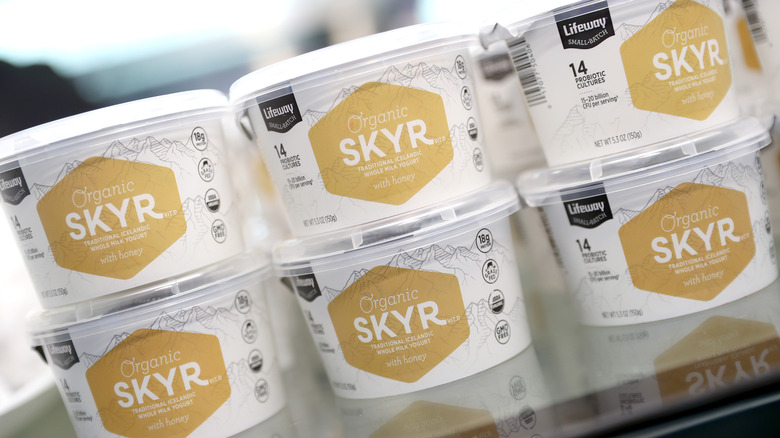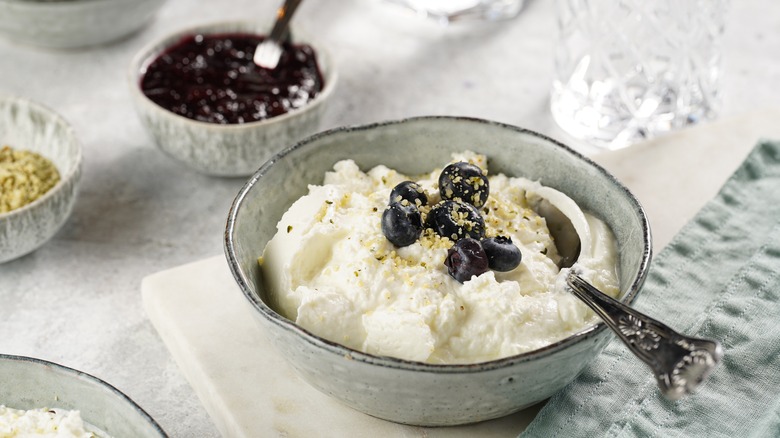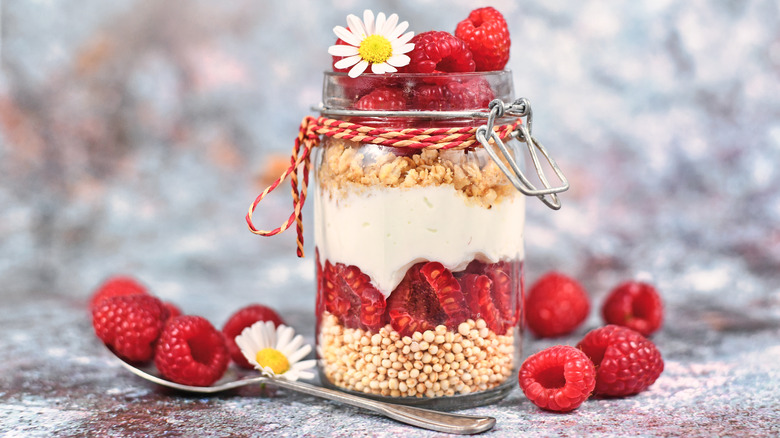What Exactly Is Icelandic Skyr?
We may receive a commission on purchases made from links.
Have you ever tried Icelandic skyr? We're not talking about the American version, which is similar in taste and texture to yogurt. The skyr produced in Iceland is very thick, with a cheese-like flavor and consistency. Think of it as a combination of Greek yogurt and soft cheese.
This traditional food is a staple of Icelandic cuisine, offering both flavor and nutrition. It has been around for over 1,000 years, and it's often referred to as the "Viking superfood" (per The Guardian). What makes it so popular is its distinct aroma and high protein content. According to Arctic Adventures, the unflavored version contains more than 12% protein and less than 1 gram of fat. Plus, it's a good source of calcium and can be used in a multitude of recipes, from cakes and puddings to ice cream.
Skyr is the new kid on American supermarket shelves, and you should consider giving it a try — unless you're lactose intolerant. As Healthline notes, this superfood fills you up quickly and may help protect against heart disease, obesity, osteoporosis, and high blood pressure when consumed as part of a balanced diet. Moreover, it keeps your bones and teeth strong and may aid in weight loss.
But what exactly is Icelandic skyr and how does it differ from yogurt or cheese?
Skyr, the Icelandic treat you'll want to include in your diet
Icelandic skyr is traditionally produced from cow's milk. Most manufacturers use skim or low-fat milk, which is heated to 165 degrees Fahrenheit for up to 20 seconds and then cooled down to 99 degrees Fahrenheit. Next, they add active bacterial cultures from a previous batch of skyr, plus milk clotting enzymes (rennet). This mixture is left to ferment for about five hours and then cooled down again, per Guide to Iceland. After that, manufacturers strain the milk to remove most of its whey, resulting in a thick, high-protein yogurt-like product.
If you think about it, this process isn't much different from cheese making. For example, Wisconsin cheese has pretty much the same ingredients, plus salt. Skyr, however, contains a special starter culture that originates in Iceland. Bulgarian yogurt, quark, labneh, and other traditional dairy products employ different bacterial cultures — hence their distinct flavor and consistency.
Skyr is often compared to yogurt or soft cheese because of its thick texture. However, the original version is much thicker than yogurt and has a creamy flavor, according to Icelandic Provisions. It is rather similar to Greek yogurt but typically contains significantly less fat since it's made with skim milk.
How to enjoy skyr
This creamy treat is delicious on its own, but you can also use it in raw desserts, baked goods, or cooked meals. Mix it with oatmeal and fruits for a healthy breakfast, blend it into smoothies and protein shakes, or add it to soups and stews to improve their texture. Skyr can also replace mayo in sandwiches and salads and makes a great substitute for sour cream in cakes, muffins, and homemade bread.
Savour Ontario suggests adding skyr to mac and cheese for a creamy texture. Another recipe comes from Canadian Living, which recommends using it in pancakes. You can also add Icelandic skyr to banana pudding or use it as a substitute for yogurt in homemade tzatziki sauce.
As a side note, consider opting for plain skyr rather than flavored varieties. The latter may contain sugar and artificial flavors, so it's not as healthy as its traditional counterpart. If you're up for a challenge, go ahead and make your own skyr. All you need is milk, sour cream, and rennet. Better yet, you can use heirloom skyr cultures, such as the Short Icelandic Skyr Culture from Positively Probiotic, for a nutritional boost.


